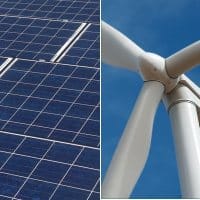Onshore wind energy now fully competitive against gas and coal in some parts of the world, while solar power is closing in says Bloomberg New Energy Finance (BNEF).
BNEF’s Levelised Cost of Electricity Update for the second half of this year states the cost of onshore wind and solar photovoltaics have dropped again this year, while costs have gone up for gas-fired and coal-fired electricity generation.
The global average levelised cost of electricity* (LCOE) for onshore wind dropped to USD$82 per megawatt-hour in the second half of 2015, while for crystalline silicon PV, i.e. solar panels, the cost fell to USD $122.
This has been attributed to not only cheaper technology, but also lower financing costs.
Meanwhile, the LCOE for coal-fired powered generation increased from $66 per MWh in the first half to $75 in H2 in the Americas, from $68 to $73 in Asia-Pacific, and from $82 to $105 in Europe.
The LCOE for combined-cycle gas turbine generation jumped from $76 to $82 in the Americas in the second half, from $85 to $93 in Asia-Pacific and from $103 to $118 in EMEA (Europe, the Middle East and Africa).
Onshore wind is now fully cost-competitive with gas-fired and coal-fired generation in the UK and Germany once carbon costs are factored in.
BNEF says coal and gas have become more expensive due to lower utilisation rates, and in the case of Europe, a higher carbon price assumption.
But what about so-called “cheap” nuclear power? BNEF says nuclear energy in the Americas and Europe rose to $261 per megawatt-hour and in the Middle East and Africa region, $158 per MWh.
The impact of the wind and solar power revolution has taken many by surprise, including Bloomberg New Energy Finance it seems.
“.. onshore wind and solar PV are both now much more competitive against the established generation technologies than would have seemed possible only five or 10 years ago,” said Luke Mills, analyst, energy economics at BNEF.
A recently released report from the International Energy Agency says renewables are expected to be the largest source of net additions to power generation capacity globally out to 2020; with wind power the major contributor, followed by solar PV.
*LCOE refers to the cost of generating a marginal megawatt-hour of electricity, plus the upfront capital and development expense, cost of equity and debt finance, operating and maintenance expenses.












































